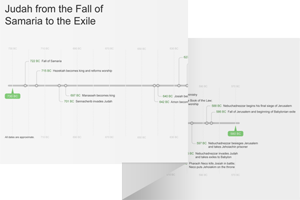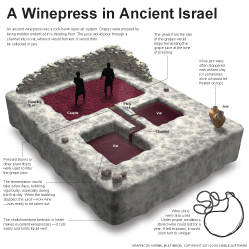1:1–5:22 The book of Lamentations |
1:1–22 The first lament focuses on Zion, |
1:1 How desolate the city sits The Hebrew title of the book comes from its opening word, ekhah (“how”). The grief over the destruction of the city is similar to the genre of “city lament” in Mesopotamian literature, where the destruction of a city is mourned and attributed to divine judgment and abandonment. Ekhah starts with the first letter of the Hebrew alphabet, aleph. Most of the poems in Lamentations follow the acrostic pattern.
full of people The Hebrew poetry of Lam 1–4 reflects a deliberate style and structure known as a qinah. This poetic form deploys intentionally unbalanced lines. This line in Lamentations, for example, uses two words in Hebrew, following the three words in the first line.
like a widow Bereaved of inhabitants (children) and husband (Yahweh). Compare Isa 54:1–7.
a woman of nobility in the provinces Laments Jerusalem’s fall from past glory. Compare Lam 5:16 and Ezek 16:10–14.
1:2 her lovers Former allies. The prophets depicted Israel’s political and spiritual abandonment of Yahweh as adultery. See Jer 3:1; 4:30; 22:20–22; 30:14; Ezek 16:26–37; 23:22–27. See note on Isa 1:21.
See Jer 3:1; 4:30; 22:20–22; 30:14; Ezek 16:26–37; 23:22–27. See note on Isa 1:21.
1:3 Judah has gone into exile Deportation was a common practice for the Assyrians and Babylonians, but it was also the ultimate punishment for breaking the covenant with Yahweh (Deut 28:64–68). Judah experienced three deportations to Babylon. See Jer 52:28–30 and note.
1:4 Zion Another name for Jerusalem, referring to the Temple Mount as the center for worship in Israel. The population has been decimated or deported and the temple destroyed, so no worshipers are coming.
1:5 Yahweh has made her suffer Judgment has come from Yahweh as a result of their sin. Compare Jer 30:14–15. Before the exile, the prophets warned Judah in vain that judgment was imminent because the people had turned away from God (e.g., Jer 11:1–13; 17:1–4). They had been warned that one of the consequences of breaking faith with Yahweh would be exile (Lev 26:33; Deut 28:36). The purpose of the discipline is correction, not destruction (compare Prov 3:11–12).
1:6 the daughter of Zion A metaphor for Jerusalem. See note on Isa 1:8.
they have gone away without strength, before the pursuer These lines may be alluding to the events described in 2 Kgs 25:3–6 when King Zedekiah and his officials fled besieged Jerusalem by night, only to be captured by the Babylonians.
and his officials fled besieged Jerusalem by night, only to be captured by the Babylonians.
1:8 they have seen her nakedness Alluding to adultery and public shame. The language of Lam 1:8–9 presents public exposure as the humiliating punishment for sexual infidelity. Similar language serves the same function in Isa 47:3; Jer 13:22, Jer 13:26; Ezek 16:37 and Nah 3:5–6.
1:9 she did not remember her future The parallel imagery from Jer 13:22 suggests personified Zion feigned ignorance that her sin was the cause of the disaster that struck her. See Jer 13:22 and note.
See, O Yahweh, my persecution The woman who personifies Zion now interjects with a cry to Yahweh. Many first-person laments in both the books of Jeremiah and Lamentations reflect the voice of personified Zion. See Jer 10:19–21 and note.
1:10 the nations, they entered her sanctuary The Babylonians plundered the temple before burning it down (see 2 Kgs 25:9–17).
to enter in your Compare Deut 23:3–6.
1:11 See, O Yahweh Personified Zion speaks. See note on Lam 1:9.
1:14 My rebellion was bound as a yoke The yoke was a symbol of judgment. See Deut 28:48. In other contexts, the yoke represents subjection to a stronger power or authority (see Isa 9:4; 58:6; Jer 5:5; 27:8). See note on Jer 5:5.
was a symbol of judgment. See Deut 28:48. In other contexts, the yoke represents subjection to a stronger power or authority (see Isa 9:4; 58:6; Jer 5:5; 27:8). See note on Jer 5:5.
1:15 a wine press, the Lord has trodden Judah is like the grapes smashed underfoot in a winepress. Compare Isa 63:2–3.
1:17 Zion stretches out her hands The first-person lament of personified Zion is interrupted with a comment from the narrator, describing the scene. Zion is looking for help and comfort.
1:18 I have rebelled against his word Jerusalem confesses that she was justly punished on account of her rebellion. Compare Jer 14:7, 20.
1:19 my priests and elders perished in the city The religious and civil leaders who led Israel astray (see Jer 2:8 and note; compare Ezek 7:26–27).
1:20 my stomach The Hebrew word refers to internal digestive organs. See note on Jer 4:19.
1:22 deal with them The poetry of the ot often contains calls like this for Yahweh to judge enemies (e.g., Pss 28:4; 35:1–28). Now that judgment has come on Jerusalem, the city longs that Yahweh’s promised day of judgment would come on the other nations (compare Isa 47:11; Jer 30:16).

|
About Faithlife Study BibleFaithlife Study Bible (FSB) is your guide to the ancient world of the Old and New Testaments, with study notes and articles that draw from a wide range of academic research. FSB helps you learn how to think about interpretation methods and issues so that you can gain a deeper understanding of the text. |
| Copyright |
Copyright 2012 Logos Bible Software. |
| Support Info | fsb |
 Loading…
Loading…




